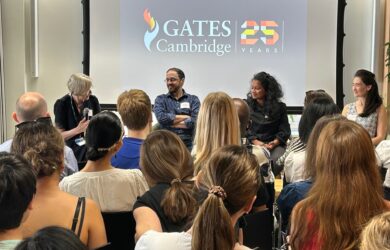Richard Butler has published a book about the history of St John's College's Master's Lodge.
A book about the history of one of Cambridge’s landmark buildings – the Master’s Lodge at St John’s College – has been published by a Gates Cambridge Scholar.
Richard Butler’s book, Secular & Domestic: George Gilbert Scott and the Master’s Lodge of St John’s College, Cambridge, is his first and traces the architectural history of the College by the prominent Victorian architect George Gilbert Scott (1811-1878). The book was launched by the Master of St John’s College, at a function in the Master’s Lodge earlier this month.
The Master’s Lodge is one of the first examples of a ‘villa’-like lodge being built at some distance from the main courts of a College. Butler says this fundamentally changed the way in which Masters lived and interacted with their Colleges, as previously it had been standard for their accommodation to be very near the Hall and Chapel, or above the main Gate. Butler [2012] who is doing a PhD in the History of Art, says: “The Master’s Lodge at St John’s College has an important place in the history of Oxbridge architecture. Scott developed a new architectural typology by moving the St John’s Lodge to a distant site where it was surrounded by trees, grass and the river. In the later nineteenth and twentieth centuries this was to become standard practice in Oxbridge.”
Scott published a key architectural treatise in 1857 called ‘Remarks on Secular & Domestic Architecture, Present and Future’, in which he argued that Gothic Revival Architecture could be used in secular buildings just as legitimately as it was being used in church architecture. However, despite this Scott built very few county houses or domestic buildings. Butler says: “That means the Lodge at St John’s gives us a rare opportunity to see his writings being worked out in practice, and it is remarkable the degree to which the building conforms with the rules, ideas and ideals propagated in his book. The book seeks to establish the importance of the building in this regard.”
The book is illustrated with over 60 colour pictures of original plans, elevations and sketches from the College archives, as well as professional photographs taken inside various parts of the Lodge. The costs of publication were paid for by a former student of the College.
With his PhD, Butler aims to write a history of Irish public architecture from the Act of Union (1801) to the late 1860s.
*Secular & Domestic: George Gilbert Scott and the Master’s Lodge of St John’s College, Cambridge is published by Esson Print, price £15.












